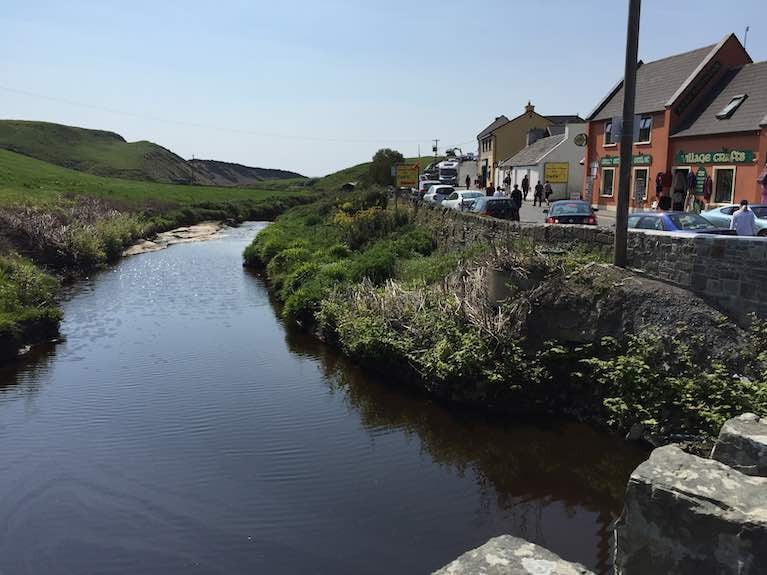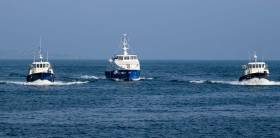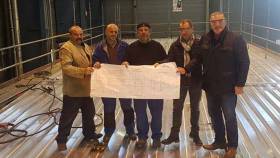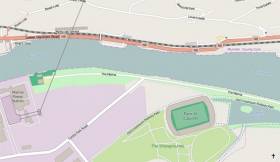Displaying items by tag: Doolin
Minister Naughton Visits Doolin Coast Guard Unit in Co. Clare
Minister with special responsibility for the Irish Coast Guard Hildegarde Naughton TD, today visited Doolin Coast Guard Unit in County Clare to meet with the local volunteer team and hear first-hand about their life saving work.
Doolin Coast Guard Unit consists of 7 volunteers and 8 more in Inis Óirr. The Unit carries out search, boat and drone roles. In 2021, a total of 41 incident taskings were responded to, and a further 49 so far in 2022. Following the recent appointments of Officer in Charge and Deputy Officer in Charge the unit continues to work on its core competencies. The skills and dedication of the volunteers who staff the Doolin Coast Guard unit have proven extremely important in the delivery of the Irish Coast Guard mission statement – both locally within their community and in support of the national service. Further expansion of the unit will be undertaken to continue to provide an effective maritime search and rescue service in County Clare.
Minister Naughton’s visits coincide with the celebration of the 200th anniversary of the Irish Coast Guard this year. The Irish Coast Guard, which can trace its roots to 1822 includes 44 Coast Guard units across Ireland provide a national maritime search and rescue service and a maritime casualty and pollution response service. Volunteers and full-time staff respond to almost 3,000 call outs and save on average 400 lives a year.
Speaking from Doolin, Minister Naughton said “The Irish Coast Guard is one of the State’s Principal Emergency Services and their work is both challenging and varied. I would like to acknowledge the commitment of staff and volunteers here in Clare, and nationwide, for providing this crucial service and particularly for maintaining service delivery throughout the Covid pandemic. I continue to hear stories of volunteers leaving their families at home in the dead of night, and even on Christmas Day, to assist those in difficulty; a fact that demonstrates the personal sacrifice that is made by our volunteers 365 days of the year. Without our volunteers we simply would not have this lifesaving service. I would also like to thank their families and the wider community without whose support this service could not be provided.”
The Irish Coast Guard is one of the State’s Principal Emergency Services and their work is both challenging and varied. I would like to acknowledge the commitment of staff and volunteers in Galway, and nationwide, for providing this crucial service and particularly for maintaining service delivery throughout the Covid pandemic. I continue to hear stories of volunteers leaving their families at home at the dead of night, or on Christmas Day, to assist a person in difficulty; a fact that demonstrates the personal sacrifice that is made by our volunteers 365 days of the year. Without our volunteers we simply would not have this lifesaving service.”
Dog Rescued by Doolin Coast Guard After Cliff Fall Drama
A dog has escaped serious injury as he was rescued from the sea after falling more than 70 feet from a cliff near Doolin in Co Clare.
As TheJournal.ie reports, Irish Coast Guard volunteers responded to the call for help from the dog’s distressed owners at Trá Lathan on Wednesday afternoon (14 September).
Doolin Coast Guard’s Emmet McNamara explained to RTÉ’s Morning Ireland on Thursday morning (15 September) how the team launched their smaller D class rescue boat in order to safety retrieve the “terrified and frightened” dog, named Bear.
The canine casualty was found sitting on a rock and attempting to climb back up the cliff to no avail — before the coastguard stepped in, using their boat hook to snag the dog’s collar and lift him aboard.
Bear was then swiftly reunited with his relieved humans, the Collins family from Athenry in Co Galway.
 The Collins family with Bear the dog and members of Doolin Coast Guard involved in his rescue on Wednesday | Credit: Irish Coast Guard/Facebook
The Collins family with Bear the dog and members of Doolin Coast Guard involved in his rescue on Wednesday | Credit: Irish Coast Guard/Facebook
Former WRC Chief Kieran Mulvey Appointed Mediator to Help Resolve Doolin Coast Guard Issues
Kieran Mulvey has been appointed as a mediator to attempt to resolve the Doolin Coast Guard crisis, as RTÉ News reports.
The former director of the Workplace Relations Commission has been appointed by Minister of State Hildegarde Naughton to step in and help to find a solution for issues within the Co Clare coastguard unit.
As previously reported on Afloat.ie, the station has been stood down after the mass resignation of six volunteers at the start of this month following years of rancour and division between members and Irish Coast Guard management.
Welcoming the appointment, local Senator Timmy Dooley said Mulvey will bring “immense experience” to the role and that he hoped “all sides will engage”. RTÉ News has more on the story.
Last week, the chairman of the new coastguard volunteers’ representative association told Afloat’s Tom MacSweeney that personnel issues have been “a blind spot” for the coastguard. Listen to the podcast HERE.
Independent Mediator Suggested to Resolve Doolin Coast Guard Crisis
TheJournal.ie reports that the Government intends to appoint an independent mediator to resolve issues at Doolin Coast Guard that led to the resignation of six volunteers last week.
Fears have been growing over the future of the Irish Coast Guard unit in Co Clare, which was left with just five active and fully trained volunteers and was subsequently stood down.
One coastguard member said the situation that involves accusations of bullying within the service “has been simmering in Doolin for years”.
Responding to a question in the Seanad the past Tuesday (9 November) from Fianna Fáil Senator Timmy Dooley, Minister of State Hildegarde Naughton suggested there is “a role for an independent person or mediator to be appointed to the Doolin unit with a view to resolving the difficulties”.
TheJournal.ie has more on the story HERE.
Doolin Coast Guard’s Future in Doubt After Mass Resignation Prompts Questions to Dáil Over ‘Toxic’ Work Environment
Fears have grown over the future of Doolin Coast Guard after the unit was suspended last week following the resignation of six volunteers members on Monday 1 November.
As the Irish Examiner reports, the Co Clare coastguard unit — which is now left with just five active and fully trained volunteers out of a complement of 11 — has been stood down.
However, Inis Óirr Coast Guard in the Aran Islands, which comes under the direct management of the Doolin unit, will remain operational.
One coastguard member said the situation that involves accusations of bullying within the service “has been simmering in Doolin for years”.
“Each and every one of those members was an invaluable asset to the service. Dublin [management] wasn’t blindsided by this but they blindly let it happen,” they said.
In a statement, the Irish Coast Guard said it “acknowledges the divisions that have unfortunately existed within the unit for a number of years”.
It added that it “will continue to offer support to all those affected by this event, and with the aim to strengthen the unit’s management structure, provide relevant training and mediation services as may be required, and return the unit to operational readiness as quickly as practicable”.
During the week the Dáil was told that the “toxic” working environment at Doolin is replicated “up and down” the country, according to The Irish Times.
It follows a report last month that paints “a picture of friction and strain” between the coastguard rank-and-file and upper management over claims of poor treatment of volunteers.
Meanwhile, a maritime lawyer has called for a “root and branch review” of the coastguard system in Ireland, as the Irish Independent reports.
Speaking to RTÉ Radio 1’s Morning Ireland on Wednesday (3 November) Michael Kingston alleged a “litany of failures” regarding volunteers’ safety within the service nationwide.
It comes in the same week that the final report into the loss of Rescue 116 and its four crew in a crash off the North Mayo coast in March 2017 was severely critical of risk management within CHC Ireland, which operates the search and rescue helicopter service for the Irish Coast Guard. Afloat.ie has more on that story HERE.
Doolin Pier & Village Masterplan Makes Progress
Michael McNamara, Independent TD for Clare, has received confirmation from Clare County Council that it is proceeding to the design stage of the proposed Doolin Pier and Village Masterplan ahead of submitting a Planning Application.
The proposed plan proposes to provide a Visitor Services Building at Doolin Pier, enhancements of the public realm of Doolin, and improvements to movement by all transport modes between the pier and the village.
Commenting on the proposed delivery of a Visitor Services Building, Deputy McNamara said, “Clare County Council’s Project Management Office is leading the Visitor Services Building Development and is currently seeking to develop the detailed design and commence the preparation of the documentation required for the various statutory consents. The Council has informed me it is anxious to submit a Planning Application at the earliest juncture possible and to this end, the Project Team has been tasked with reviewing and revising the various works required with a view to finalising an updated programme for delivery of the scheme.”
 Michael McNamara, Independent TD for Clare
Michael McNamara, Independent TD for Clare
“There is a requirement for additional lands for this proposal and despite the Council’s best endeavours, it has not been possible to secure the necessary lands needed by agreement. Therefore, it is intended to seek approval from An Bord Pleanála to acquire them compulsorily in parallel with the Planning application for the scheme,” he added.
In relation to the to the Doolin Village Masterplan, Deputy McNamara said plans are advanced and funding applications are currently being pursued by the West Clare Municipal District.
“These funding sources will be crucial in ensuring the implementation of the overall plan,” he added.
Deputy McNamara welcomed the progress being made on the Village Masterplan by the Local Authority’s West Clare Municipal District office.
“Earlier this year Clare County Council completed a footpath with public lighting from Fitz’s Cross to Fisher Street,” commented Deputy McNamara. “This work was completed in phases over the last few years. No works have taken place at the port apart from maintenance and repair of storm damage. It is proposed to fill in the steps on the new pier prior to next year’s season. A Port Facility Security Plan is currently being drafted, as required by the Department of Transport. This will guide the Council in infrastructure developments and staffing requirements at the port in the coming years.”
“Clare County Council is also working with Failte Ireland on the Wild Atlantic Way Infrastructure Improvement Programme and part of this includes for draft ideas in relation to parking issues at Fisher Street. This is only at concept design stage. No landowner engagement has taken place yet, and this must be a priority if the Plan is to be realised,” concluded Deputy McNamara.
Maiden Voyage into Doolin as Ferry Operations to the Aran Islands & Cliffs of Moher Commence
The Aran Islands got closer this week as the fastest and most eco-friendly passenger cruise ship to operate on the western seaboard sailed into Doolin for the first time following a €3m investment.
The Doolin2Aran operated ‘Star of Doolin’ completed the 650 nautical mile journey from La Rochelle in France and sailed into Doolin Pier in splendid morning sunshine to cheers from tourists and locals and - naturally for the North Clare village recognised as the home of traditional Irish music - strains of box, fiddle, banjo and pipes.
Following regulatory sign-off by Department of Transport officials, the boat was operating to the three Aran Islands and Cliffs of Moher by mid-afternoon.
 There were wild morning celebrations on Doolin Pier as the ‘Star of Doolin’ sailed in for the first time. Photo: Arthur Ellis
There were wild morning celebrations on Doolin Pier as the ‘Star of Doolin’ sailed in for the first time. Photo: Arthur Ellis
The ship, will be the fastest and largest to operate to the islands from Doolin, halving journey times and doubling capacity of the company’s existing boats. It has also been designed with the environment in mind, with additional features to lower emissions and state of the art waste water treatment on board.
The investment by Doolin2Aran, which is owned and operated by one of Ireland’s best-known sea families, the Garrihys from Doolin, is the biggest ever made in a single vessel on the west coast of Ireland. The one-off designed, 200 seat cruise ship is also tailored for international tourists, with multi-lingual voice commentary to ensure visitors get the absolute experience and knowledge of the world-famous heritage sites.
Hundreds gathered on Doolin Pier to welcome the ship back in, led by legendary Clare concertina player Chris Droney (93), who gave the boat its name. Chris is father in law of Eugene Garrihy – one of four Garrihy brothers with PJ, Joe and Donie involved in the business.
"Hundreds gathered on Doolin Pier to welcome the ship back in"
The 25m ship was sailed back from La Rochelle to Doolin, with an overnight in Dingle, at the weekend by skipper PJ Garrihy and his crew. They spent Monday night at the Aran Islands as locals, who will benefit from the investment through quicker journey times and more tourists, got a preview of the new vessel.
“It’s a great day for Doolin, for West Clare and for the Aran Islands,” said PJ Garrihy. “It was a lovely trip back. It’s such a comfortable ship and will be a great service to West Clare and the islands. We couldn’t wait to get her back and were blown away by the crowds on the pier for us so early today.”
Said PJ’s brother Eugene, “This is the end of an 18 month journey for us. We took the decision back in late 2016. It was a big move because we’re a small family business and it’s a very big investment for us but now that the ship is back, we’re delighted. It will be a huge boost to tourism in the West of Ireland but particularly here in Doolin and the Aran Islands.
“It ticks all the boxes. While it can take more passengers and operate at twice the speed, it has also been designed with the environment as a core consideration. We’re operating here out of the Burren and Cliffs of Moher Geopark and it was a priority for us to get emissions as low as possible and we’ve done that.”
Garrihy’s daughter Aoibhín, who is due her first child with husband John Burke, in three weeks’ time was also on the pier. “I’m very proud of what’s been achieved here. I got my first job here working in the summers and I just love the place. A lot of hard work, including in difficult times, has gone into this by the family, by people employed here and it’s great to seeing it pay off.”
Her grandfather Chris was in sprightly form, the celebratory mood even seeing him dancing a set on the pier. “I was here 70 and 80 years ago and there was nothing. Now it’s a thriving pier but it didn’t happen overnight. It’s great to see progress like this,” he said.
€3m 'Cruise Ship' to Launch on Doolin–Aran Islands Crossing & Cliffs of Moher Cruises
Accessing Ireland’s most popular offshore destination, the Aran Islands, and the Cliffs of Moher by sea is to get a lot more comfortable, faster and environmentally friendly thanks to a record investment by one of the best known sea faring families on the west coast.
In what will be the biggest single private transport infrastructure investment on the Wild Atlantic Way, the Garrihy family run business, Doolin2Aran Ferries, has commissioned a state of the art, €3m new vessel that is being built by OCEA Shipbuilding in La Rochelle, France. This is the first ship to be built for the popular port of Doolin this decade, the last one being the Doolin Discovery, which was also commissioned by the Garrihy family in 2009.
Doolin2Aran Ferries is owned and operated by the Garrihy family from Doolin, who have been operating commercially on the seas around Doolin for half a century.
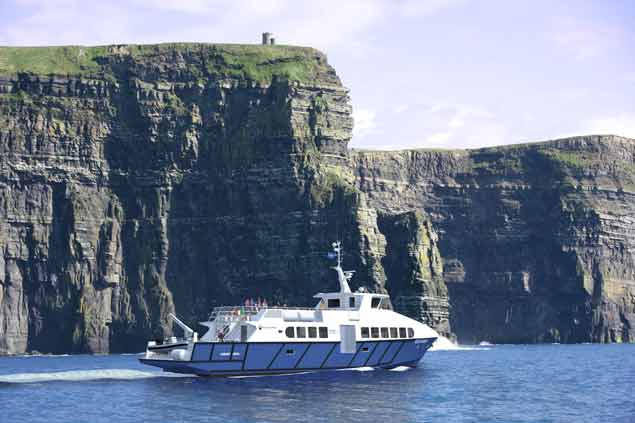 An artist’s impression of the new 26m Doolin to Aran Ferries cruise ship being built in France
An artist’s impression of the new 26m Doolin to Aran Ferries cruise ship being built in France
The 26–metre vessel will be the fastest and most comfortable domestic cruise ship on the entire Irish coast. It will operate daily sailings to the Aran Islands as well as the stunning cruise to the foot of the Cliffs of Moher, one of the West coast’s most captivating tourism experiences.
The one-off designed cruise ship will also be tailored for international tourists, with multi-lingual voice and visual guide systems to ensure visitors get the absolute experience and knowledge of the world-famous heritage sites.
In production since late October, the 200-seat vessel will have the highest specification available. It will incorporate system built seating and air conditioning, and the most advanced computerised stability system providing quality and comfort to passengers.
The ship also embraces the latest in terms of environmentally friendly technologies with a high-tech, on-board waste water treatment plant and TIER ii advanced low emission energy efficient engines.
The shipbuilders, OCEA, are one of Europe’s leading specialist manufacturers of ships for the leisure and commercial markets. Building up to 20 vessels per year, and for some of the world’s most high net-worth individuals, OCEA operates across four production sites, with 95% of its turnover garnered from the export markets. Its biggest build to date is an €80m patrol boat for a Middle Eastern client.
On completion, the Doolin2Aran Ferries vessel will be sailed back from La Rochelle, with stops in Brest in North West France before making its way to Doolin where it will join the fleet of Doolin2Aran Ferries vessels, helping to accommodate the huge increase in popularity of cruises to the islands and the Cliffs of Moher since the launch of the Wild Atlantic Way brand. It will be the largest operator sailing out of the hugely popular Aran Islands gateway pier. The Garrihy family also own and operate The Happy Hooker, The Rose of Aran, The Jack B, The Doolin Discovery and the St Bridget, which operates on Dublin Bay.
Commenting on the investment, Eugene Garrihy of Doolin2Aran Ferries said: “We worked hard to get the new improved pier facilities at Doolin and now we are investing in this state of the art vessel. We have grown the business year on year and we feel the time is right to take our business to a new level with this investment. The Wild Atlantic Way is proving a global tourism phenomenon and we have to respond in the industry by improving the quality of our offering to ever more discerning customers.
“With good visitor management and continued engagement with all tourism bodies, we are confident that the impact of this investment in the region will be very positive. The ship will be the largest and fastest operating to the islands from Doolin. As it will operate in the UNESCO Burren and Cliffs of Moher Geopark, we were also particularly conscious that it would be the most energy efficient and sustainable vessel operating here and is being custom built to that end.
“We’re really looking forward to its completion and getting it back here. There’ll be nothing like it for tourists heading out from the west coast.”
Coastguard In Medevac From Irish Fishing Vessel
#Coastguard - Shannon's Irish Coast Guard helicopter was launched yesterday afternoon (Tuesday 14 June) to evacuate an injured crewmember from an Irish fishing vessel off the Kerry coast.
Top cover was provided by a second coastguard helicopter as Rescue 115 flew to the boat 120 miles west of the Blasket Islands to recover the injured party for treatment.
In another incident, coastguard volunteers recovered the body of a man from the base of the Cliffs of Moher last night, as BreakingNews.ie reports.
Units from Doolin and Kilkee responded when the alarm was raised around 5pm yesterday, eventually lifting the body to the cliff top four hours later. Gardaí are investigating.
Divers Find Car In River Lee After Morning Search
#RiverLee - Divers have found a car submerged in the River Lee in Cork just hours after it was seen entering the water this morning (Friday 6 May).
BreakingNews.ie reports that a member of the public spotted the vehicle near the Lee Rowing Club with its boot sticking out of the water around 6am, prompting an immediate search and rescue response.
The car was subsequently located after a search of the river and divers from Haulbowline are assessing the scene, as RTÉ News reports.
In other news, a young tourist is recovering after he was swept onto rocks by an unexpected wave at Doolin in Co Clare yesterday (Thursday 5 May).
The 25-year-old American sustained multiple injuries after the wave knocked him off the shoreline at the popular beauty spot, according to BreakingNews.ie.


























